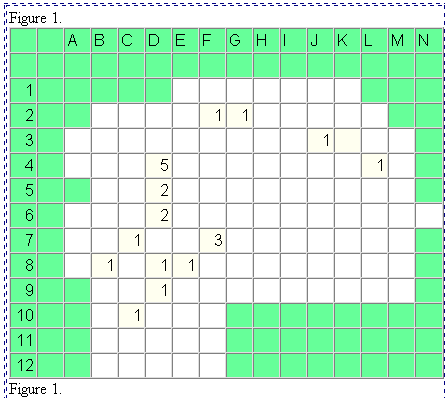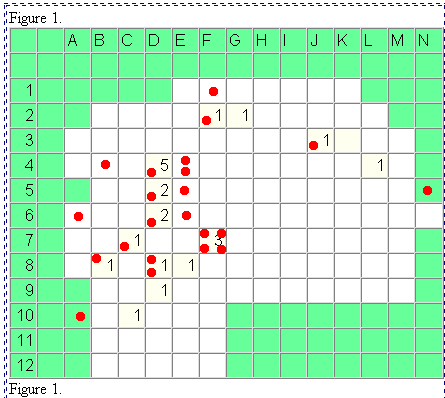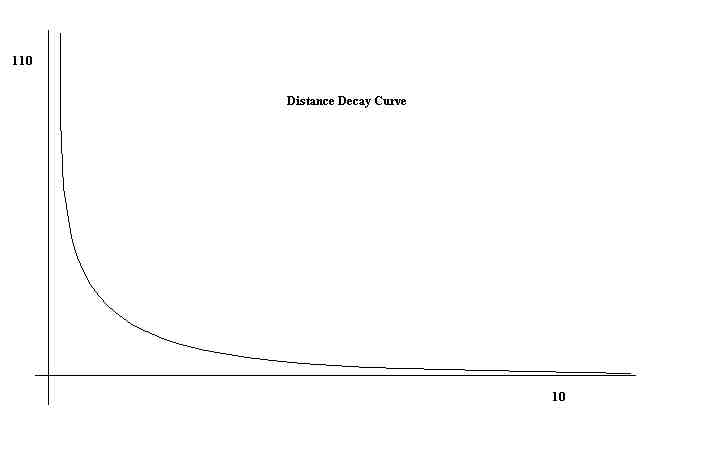HAGERSTRAND'S MEASUREMENT OF THE DIFFUSION OF
AN INNOVATION
Torsten Hägerstrand, a Swedish geographer at the University of
Lund, used the following technique to trace the diffusion of an innovation.
-
The ‘thing’ being diffused (communicated) is an idea;
-
the agents of diffusion, or carriers of new information, are human beings;
-
the space in which the idea is to be diffused is a region of the world.
Hagerstrand traces the diffusion process by imitating it with numbers.
Such imitation, leading to prediction or forecasting of the pattern of
diffusion, is called a simulation of diffusion. To follow the mechanics
of this strategy, it is necessary only to understand the concepts of ordering
the non-negative integers and of partitioning these numbers into disjoint
sets.
The figure on the left shows the spatial distribution of the number
of individuals accepting a particular innovation after one year of observation
(Hägerstrand, p. 380). The figure on the right shows a map of
the same region and of the pattern of acceptors after two years--based
on actual evidence. Notice that the pattern at a later time shows both
spatial expansion and spatial infill (more concentrated use and greater
density per unit of land area). These two latter concepts are enduring
ones that appear over and over again in spatial analysis---as well as in
planning at municipal and other levels.
Figure 1.
| aa |
a |
A |
B |
C |
D |
E |
F |
G |
H |
I |
J |
K |
L |
M |
N |
|
a
|
a |
a |
a |
a |
a |
a |
a |
a |
a |
a |
a |
a |
a |
a |
a |
|
1
|
a |
a |
a |
a |
a |
|
|
|
|
|
|
|
a |
a |
a |
|
2
|
a |
a |
|
|
|
|
1
|
1
|
|
|
|
|
|
a |
a |
|
3
|
a |
|
|
|
|
|
|
|
|
|
1
|
|
|
|
a |
|
4
|
a |
|
|
|
5
|
|
|
|
|
|
|
|
1
|
|
a |
|
5
|
a |
a |
|
|
2
|
|
|
|
|
|
|
|
|
|
a |
|
6
|
a |
|
|
|
2
|
|
|
|
|
|
|
|
|
|
|
|
7
|
a |
|
|
1
|
|
|
3
|
|
|
|
|
|
|
|
a |
|
8
|
a |
|
1
|
|
1
|
1
|
|
|
|
|
|
|
|
|
a |
|
9
|
a |
a |
|
|
1
|
|
|
|
|
|
|
|
|
|
a |
|
10
|
a |
a |
|
1
|
|
|
|
a |
a |
a |
a |
a |
a |
a |
a |
|
11
|
a |
a |
|
|
|
|
|
a |
a |
a |
a |
a |
a |
a |
a |
|
12
|
a |
a |
|
|
|
|
|
a |
a |
a |
a |
a |
a |
a |
a |
Figure 1. |
Figure 2.
| aa |
a |
A |
B |
C |
D |
E |
F |
G |
H |
I |
J |
K |
L |
M |
N |
|
a
|
a |
a |
a |
a |
a |
a |
a |
a |
a |
a |
a |
a |
a |
a |
a |
|
1
|
a |
a |
a |
a |
a |
|
|
|
|
|
|
|
a |
a |
a |
|
2
|
|
|
|
|
|
|
1
|
1
|
|
|
|
|
|
a |
a |
|
3
|
a |
|
|
|
1
|
|
|
|
|
1
|
1
|
|
|
|
a |
|
4
|
a |
|
|
|
6
|
1
|
|
|
|
|
1
|
|
1
|
|
a |
|
5
|
a |
a |
|
|
2
|
1
|
|
|
|
|
|
|
|
|
a |
|
6
|
a |
|
|
|
5
|
|
|
|
|
|
|
|
|
|
|
|
7
|
a |
|
|
1
|
1
|
1
|
3
|
|
|
|
|
|
|
|
a |
|
8
|
a |
|
1
|
1
|
2
|
2
|
|
|
|
|
|
|
|
|
a |
|
9
|
a |
a |
1
|
|
1
|
|
|
|
|
|
|
|
|
|
a |
|
10
|
a |
a |
|
1
|
|
|
|
a |
a |
a |
a |
a |
a |
a |
a |
|
11
|
a |
a |
|
|
|
|
|
a |
a |
a |
a |
a |
a |
a |
a |
|
12
|
a |
a |
|
|
|
|
|
a |
a |
a |
a |
a |
a |
aa |
a |
Figure 2. |
Might it have been possible to make an educated guess, from Figure 1
alone, as to how the news of the innovation would spread? Could the right-hand
figure above have been generated/predicted from the left-hand figure using
some replicable, systematic process? The steps below will use the grid
in Figure 3 to assign random numbers to the grid in Figure 1, producing
Figure 4 as a simulated distribution, as opposed to the actual distribution
of Figure 2, of acceptors after two years.
-
Construct a "floating" grid (Figure 3) to be placed over the grid on the
map of Figure 1, with grid cells scaled suitably so that they match. Center
the floating grid on a square in Figure 1 in which there exists an adopter
(say 2F)...this is the first cell, working left to right and top to bottom,
which contains a numeral. The numbers in the floating grid, used with a
set of four digit random numbers, will be used to determine likely location
of new adopters. It is assumed that the adopter in F2 (or in any other
cell) is more likely to communicate with someone nearby than with someone
far away (Tobler's Law--Newton...); velocity of diffusion is expressed
in terms of probability of contact.
FIGURE 3. Floating grid on the right; random numbers in the center;
mean information field--assignment of four digit numbers reflects probability
of contact; in this case symmetric, but assignment might reflect decisions
about boundaries and other physical or human features. There are
22 initial adopters and thus 22 random numbers. Different sets of
random numbers produce results that are different from each other in terms
of detail of distribution but not in terms of general pattern of clustering,
infill, and spatial extension.

|
6248
0925
4997
9024
7754
7617
2854
2077
9262
2841
9904
9647
3432
3627
3467
3197
6620
0149
4436
0389
0703
2105
|
0000
to
0095
|
0096
to
0235
|
0236
to
0403
|
0404
to
0543
|
0544
to
0639
|
0640
to
0779
|
0780
to
1080
|
1081
to
1627
|
1628
to
1928
|
1929
to
2068
|
2069
to
2236
|
2237
to
2783
|
2784
to
7214
|
7215
to
7761
|
7762
to
7929
|
7930
to
8069
|
8070
to
8370
|
8371
to
8917
|
8918
to
9218
|
9219
to
9358
|
9359
to
9454
|
9455
to
9594
|
9595
to
9762
|
9763
to
9902
|
9903
to
9999
|
|
This assumption regarding distance and probability of contact is reflected
in the assignment of numerals within the grid--there are the most four
digit numbers in the central cell, and the fewest in the corners. The floating
grid partitions the set of four digit numbers {0000, 0001, 0002, ..., 9998,
9999} into 25 mutually disjoint subsets.
FIGURE 4. Here, the Mean Information Field collects new adoopters
(red dots). The transformation described above is animated to illustrate
it.
Given a set (or sets) of four digit random numbers--as below. Center
the floating grid on F2. The first random number is 6248 and it lies
in the center square of the overlay. So in the simulation, the acceptor
in F2 finds another acceptor nearby in F2. Record that simulated acceptor
as a red dot. Together with the original adopter, there are now two adopters
in this cell. Move the MIF over and repeat the procedure using the
next random number in the sequence.
FIGURE 5. Simulated distribution of acceptors, using random numbers.
Original acceptors in black; simulated acceptors in red. Consider
what to do with edge effect issues. How does the simulation compare
to the actual distribution of adopters after two years (Figure 2)?
This question leads to a whole set of issues about how to compare pattern--one
might use color, contours, a variety of numerical measures, and so forth.
Attached is a rough idea using this particular
small example.
 |
| a |
a |
A |
B |
C |
D |
E |
F |
G |
H |
I |
J |
K |
L |
M |
N |
|
a
|
a |
a |
a |
a |
a |
a |
a |
a |
a |
a |
a |
a |
a |
a |
a |
|
1
|
a |
a |
a |
a |
a |
|
1 |
|
|
|
|
|
a |
a |
a |
|
2
|
a |
a |
|
|
|
|
1+1
|
1
|
|
|
|
|
|
a |
a |
|
3
|
a |
|
|
|
|
|
|
|
|
|
1+1
|
|
|
|
a |
|
4
|
a |
|
1 |
|
5+1
|
1+1 |
|
|
|
|
|
|
1
|
|
a |
|
5
|
a |
a |
|
|
2+1
|
1 |
|
|
|
|
|
|
|
|
1 |
|
6
|
a |
1 |
|
|
2+1
|
1 |
|
|
|
|
|
|
|
|
|
|
7
|
a |
|
|
1+1
|
|
|
3+1+3
|
|
|
|
|
|
|
|
a |
|
8
|
a |
|
1+1
|
|
1+1+1
|
1
|
|
|
|
|
|
|
|
|
a |
|
9
|
a |
a |
|
|
1
|
|
|
|
|
|
|
|
|
|
a |
|
10
|
a |
1 |
|
1
|
|
|
|
a |
a |
a |
a |
a |
a |
a |
a |
|
11
|
a |
a |
|
|
|
|
|
a |
a |
a |
a |
a |
a |
a |
a |
|
12
|
a |
a |
|
|
|
|
|
a |
a |
a |
a |
a |
a |
a |
a |
|
Construction of the floating grid--the so-called "Mean Information
Field" (MIF) in the original example.
Assumption: the frequency of social contact (migration) per square kilometer
falls off (decays) rapidly with distance.
The data are from an empirical study.
Units on axes: x-axis--distance in kilometers; y-axis--number of migrating
households per square kilometer.

Definition: An area containing probabilities of receiving information
from the central point of that region is called a mean information field.
To assign quantitites of four digit numbers to each cell in the MIF,
it is necessary to use the curve derived from the empirical study (distance
decay curve).
It is used to
-
determine the size of the MIF
-
assign particular probabilities.
Size of MIF
The size of the MIF is 25 by 25 kilometers squared. Observation is that
the typical household moves no more than 12.5 kilometers. This field is
then split into cells 5 by 5 kilometers squared.
Assignment of probabilities
From the graph of distance decay, a point 10 km from the center has
a value of .167 associated with it. This is in households per square kilometer;
there are 25 km squared in each cell; so the point value of the cell is
25*.0167=4.17. The center cell has a value of 110--an actual number of
households.
The total point value of all cells is 248.24--note the symmetry caused
by assumptions about ease of movement in all directions outward from the
center.
Divide: 4.17/248.24=0.0168---so, assign 168 4 digit numbers to the cells
that are 10 km from the center (two to the north, east, south, and west
of center).
Thus, the Mean Information Field is constructed.
Some Basic Assumptions of the Simulation Method (Monte Carlo)
Assumptions to create an unbiased gaming table:
-
the surface is uniform in terms of population and transport
-
all contacts are equally easy in any direction
-
there are an equal number of potential acceptors in each cell
Rules of the game:
-
There is a set of carriers at the start (as in Figure 1)
-
information is transmitted at constant intervals
-
when carrier meets a new person, acceptance is immediate
-
the likelihood of a carrier and another meeting depends on the distance
between them.
Reference:
Hägerstrand, Torsten. Innovation Diffusion as a Spatial Process.
Translated by Allan Pred. University of Chicago Press, 1967.
